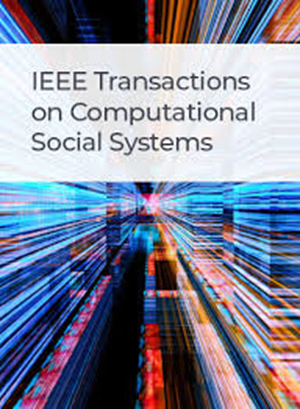A Novel Retrospective-Reading Model for Detecting Chinese Sarcasm Comments of Online Social Network
IF 4.5
2区 计算机科学
Q1 COMPUTER SCIENCE, CYBERNETICS
IEEE Transactions on Computational Social Systems
Pub Date : 2024-10-17
DOI:10.1109/TCSS.2024.3470317
引用次数: 0
Abstract
Through the use of sarcastic sentences on social media, people can express their strong emotions. Therefore, the detection of sarcasm in social media has received more and more attention over the past years. Classifying a sentence as sarcastic or nonsarcastic heavily relies on the contextual information of the sentence. However, only focusing on the features of target text is the main solution of most existing research. Moreover, the scale of publicly available Chinese sarcasm dataset is very small and does not contain the contextual information. To address the issues mentioned above, we build a Chinese sarcasm dataset from Bilibili, which is one of the most widely used social network platforms in China and has a significant number of sarcastic comments and contextual information. As far as we know, our dataset is the first publicly available large-scale Chinese sarcasm dataset including contextual information. Additionally, we have proposed a novel retrospective reading method for detecting sarcasm that leverages contextual information to improve model's performance. The experimental results show the effectiveness of the proposed model and the significance of contextual information for Chinese sarcasm detection: achieving the highest F-score of 0.6942, outperforming existing state-of-the-art (SOTA) approaches. The study presented in this article offers approaches and ideas for future Chinese sarcasm detection studies.一种基于回顾阅读的在线社交网络中文讽刺评论检测模型
通过在社交媒体上使用讽刺句子,人们可以表达自己强烈的情绪。因此,近年来,社交媒体中讽刺语的检测受到越来越多的关注。将一个句子划分为讽刺或非讽刺在很大程度上依赖于句子的上下文信息。然而,大多数现有研究的主要解决方案是只关注目标文本的特征。此外,公开的中文讽刺数据集规模很小,不包含上下文信息。为了解决上述问题,我们从Bilibili建立了一个中文讽刺数据集,Bilibili是中国使用最广泛的社交网络平台之一,拥有大量的讽刺评论和上下文信息。据我们所知,我们的数据集是第一个公开可用的包含上下文信息的大规模中文讽刺数据集。此外,我们提出了一种新的回顾性阅读方法来检测讽刺,利用上下文信息来提高模型的性能。实验结果表明了该模型的有效性和上下文信息对中文讽刺检测的重要性:达到了最高的f值0.6942,优于现有的最先进的(SOTA)方法。本文的研究为今后的汉语讽刺语检测研究提供了方法和思路。
本文章由计算机程序翻译,如有差异,请以英文原文为准。
求助全文
约1分钟内获得全文
求助全文
来源期刊

IEEE Transactions on Computational Social Systems
Social Sciences-Social Sciences (miscellaneous)
CiteScore
10.00
自引率
20.00%
发文量
316
期刊介绍:
IEEE Transactions on Computational Social Systems focuses on such topics as modeling, simulation, analysis and understanding of social systems from the quantitative and/or computational perspective. "Systems" include man-man, man-machine and machine-machine organizations and adversarial situations as well as social media structures and their dynamics. More specifically, the proposed transactions publishes articles on modeling the dynamics of social systems, methodologies for incorporating and representing socio-cultural and behavioral aspects in computational modeling, analysis of social system behavior and structure, and paradigms for social systems modeling and simulation. The journal also features articles on social network dynamics, social intelligence and cognition, social systems design and architectures, socio-cultural modeling and representation, and computational behavior modeling, and their applications.
 求助内容:
求助内容: 应助结果提醒方式:
应助结果提醒方式:


